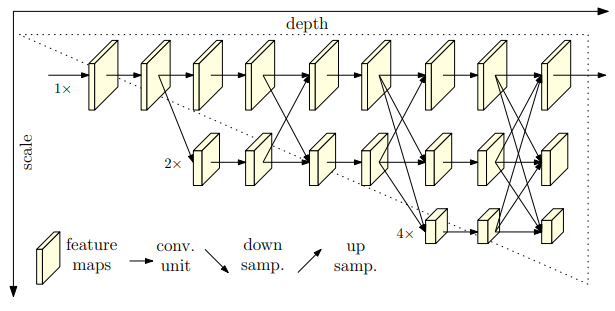HRNet human pose estimation 논문
미미로그 논문 리뷰 을 참고하여 작성하였다.
Abstract
HRNet에서 제공하는 network는 높은 해상도를 전체 프로세스 동안 유지하는 특징을 가지고 있다.
: maintains high reoslution representations through whole process
high resolution subnetwork를 시작으로 점점 stage 추가를 위해 high-to-low resolution subnetwork를 추가하며, multi resolution subnetwork를 "parallel"하게 연결한다.
반복되는 multi-scale fusions를 구성하여 각각의 high-to-low resolution representations가 다르느 parallel representation으로부터 정보를 계속해서 얻을 수 있게끔 해준다.
결과적으로 이런 방식을 통해 keypoint heatmap의 좀 더 세밀하고 정확한 결과가 나온다.
Introduction
human pose estimation은 keypoint들의 위치를 예측하는데에서부터 시작한다. 이 논문은 single person pose estimation에 초점을 두고 있다. 현존하는 methods 중 input은 network(series하게 연결된 high-to-low resolution subnetwork)를 통과하면서 그 이후에 resolution을 증가시킨다.
HRNet
HRNet은 새로운 구조 "HRNet"을 선보이는데, 앞서 말했듯 모든 process에서 high resolution을 유지하는 구조를 지닌다.
첫번째 stage에서 high resolution subnetwork에서 시작하여, 점진적으로 high-to-low resolution subnetwork를 추가하고 parallel하게 multi-resolution subnetworks들을 연결한다.
반복적으로 multi-scale fusions를 구성하여, 전체적인 process 동안 parallel하게 연결된 multi-resolution subnetworks간 정보를 교환해준다.
예측은 high resolution representations output으로 한다.

다른 network에 비해 HRNet network가 가진 이점이 2가지 존재한다.
1) connection of high to low resolution is in parallel not in series
→ maintain high resolution without recovering by low-to-high process
→ heatmap precise
high-to-low resolution의 연결이 parallel하게 되어 있기 때문에, process 내내 높은 해상도를 유지할 수 있어 low-to-high process가 불필요하다. 이로인해 heatmap이 더 세밀하게 추출된다.
2) repeat multi scale fusions to boost the high-resolution representations with the help of the low-resolution representations of the same depth and similar level
multi scale fusion을 반복적으로 사용하여 같은 depth, 비슷한 level의 low-resolution이 high resolution representation을 지원해주도록 한다.
따라서 heatmap의 정확도가 올라간다.
Related work
Multi-scale fusion
multi-resolution 이미지들을 각각 따로 multiple networks에 넣고 각각의 output response maps들을 aggregate(합치다)한다.
Intermediate supervision
중간에 loss를 계산하는 intermediate supervision은 deep netwrok 학습에 도움이 되고, heatmap 예측의 질을 높여주어 많이 사용되었다. Hourglass 나 CPM의 경우 intermediate heatmap을 다음 stage의 input값으로 넣기도 하였다.
✔ Our approach
HRNet은 앞서 계속 언급했듯, high-to-low subnetworks를 parallel하게 연결하여 high-resolution representations를 전체 process동안 유지시켜준다. 반복적으로 high-to-low subnetworks들의 representation을 fuse함으로써, high-resolution representation을 생성한다. 이로 인하여 개선된 heatmap estimation이 가능해진다.
차이점이 존재한다면, 분리된 low-to-high upsampling process가 필요하고 low-level 과 high-level representations들을 합쳐준다.
Intermediate supervision을 사용하지 않고서도 keypoint detection 정확도가 높고, 계산 복잡도에서도 효율적인 모습을 보여준다.
Approach
Human pose estimation (keypoint detection)은 W x H x 3 크기의 input 으로부터 K 개의 keypoint들을 detect하여 location을 파악하는 것을 목표로 한다.
Pipline
1) stem consisteing of 2 strided convolutions decreasing the resolution
해상도를 낮추는 stride가 2인 conv 으로 시작한다.
2) main body outputting the feature maps with the same resolution as its input feature maps
input feature maps와 해상도가 같은 output feature map을 생성하는 main body
3) a regressor estimating the heatmaps where the keypoint positions are chosen and transformed to the full resolution
keypoint 위치를 선정하는 heatmap을 예측하는 regressor
여기서 Main body는 HRNet(high resolution Net)을 사용한다.
Sequential multi-resolution subnetworks
기존의 network은 high-to-low resolution subnetworks들을 series하게 연결하여 각 stage를 구성하는 subnetwork들은 convolutions들로 구성되어 있고, resolution을 반으로 낮추는 down-sample layer가 adjacent subnetworks에 존재했다.

여기서 s는 stage, r 이 resolution index라 한다. (첫번째 resolution보다 1/2^(r-1) resolution을 지님)

따라서 high to low network stages는 위와 같이 나타낼 수 있다. (series하게 연결)
Parallel multi-resolution subnetworks
high-resolution subnetwork으로 first stage를 시작하여 점진적으로 high-to-low resolution subnetworks를 stage별로 하나씩 추가하고, multi-resolution subnetworks들을 parallel하게 연결한다.
따라서 결과적으로 나중의 stage의 resolution은 이전 stage의 resolution과 lower one으로 구성되어 있다.
예를들어, 4개의 parallel한 subnetwork을 지닌 network structcure를 보면 다음과 같다.

따라서 정리하자면,

Repeated multi-scale fusion
exchange units across parallel subnetworks : 다양한 scale을 반복적으로 fusion하는 과정에서 Exchage Unit이란게 사용된다.

서로다른 resolution의 정보를 합칠 때는 적절하게 upsampling/downsampling하는 것이 필요하다. 아래 그림은 stage 3를 여러 exhange block으로 나눈 그래프이다.

3번째 stage를 3개의 exchange blocks로 나누었고 각각의 block은 3개의 exchange units와 함께 parallel convolution units 로 구성되어있다.

여기서 a(Xi,k)의 a()함수는 resolution을 i에서 k로 변환시키는 것을 의미한다. 따라서 1부터 s까지 k로의 resolution 변환을 구하여 합한것을 Yk 라고한다.
Heatmap Estimation
최종적으로 heatmap은 Last exchange unit Ys+1 으로부터 나온 high-resolution representations output 으로 regress한다.
Loss Function은 평균 제곱 오차 MSE를 사용한다. 여기에 사용되는 GT heatmap은 각 keypoint에 2D 가우시안 분포를 적용해서 구한다.
Network instantiation
Mainbody HRNet은 4개의 stage, 4개의 parallel subnetwork을 지닌다.
resolution이 1/2이 될때마다 width은 2배로 증가한다.
stage1 : 4 residual units
각 units은 ResNet-50과 같이 width가 64인 Bottleneck과 함께 feature의 width를 C로 줄여주는 3x3 convolution 을 가진다.
stage2,3,4는 각각 1,4,3, exhange blocks를 가지고, 하나의 exchange block은 4개의 residual units(각 units은 2개의 3x3 convolutions 을 지닌다)과 exchange unit을 가진다.
따라서 총 8개의 exchange units과 8개의 multi-scale fusions가 구성된다.
